You are using an out of date browser. It may not display this or other websites correctly.
You should upgrade or use an alternative browser.
You should upgrade or use an alternative browser.
I need some group diagnostic help
- Thread starter ACLakey
- Start date
Do you see how the point of impact is shifting around?
That indicates something is loose, bad scope, or changing winds.
Your groups can also indicate a very copper fouled barrel.
If you continue to get 3 and 2, then chances are it is bedding or bullet seating depth.
Your rifle may not like the bullet that you are shooting at all...which is the case much of the time.
Good luck!
That indicates something is loose, bad scope, or changing winds.
Your groups can also indicate a very copper fouled barrel.
If you continue to get 3 and 2, then chances are it is bedding or bullet seating depth.
Your rifle may not like the bullet that you are shooting at all...which is the case much of the time.
Good luck!
I'm guessing that it might be something in the bullet/brass/powder combo.
You can't load those 40gr too close to the lands due to their short lengths.
May be neck tension.
How many times has this brass been loaded?
Has it been annealed?
What kind of neck lube are you using?
Have you checked brass concentricity?
Have you weighed and sorted your brass?
Have you checked loaded round concentricity?
Have you weighed and sorted your loaded cartridges?
Switching to Lapua brass tightened up the groups in both of my Savage 223AIs.
You can't load those 40gr too close to the lands due to their short lengths.
May be neck tension.
How many times has this brass been loaded?
Has it been annealed?
What kind of neck lube are you using?
Have you checked brass concentricity?
Have you weighed and sorted your brass?
Have you checked loaded round concentricity?
Have you weighed and sorted your loaded cartridges?
Switching to Lapua brass tightened up the groups in both of my Savage 223AIs.
Thanks for the information. Through my trouble shooting with the rifle I took the scope off and checked the bases. The front base screws felt loose so I attempted to remove them to find they were stripped. It seems the screws were too short and only grabbed with about 1/16" of thread which gave way. I replaced with longer screws and will try to get to the range in a week...busy with home improvements this weekend. Thanks for the information and I will post results. I will also have a buddies Leupold VX III on had to try as well.
claimbuster
New member
"group diagnostic help", is that anything like group therapy?
/ubbthreads/images/graemlins/grin.gif /ubbthreads/images/graemlins/grin.gif /ubbthreads/images/graemlins/grin.gif /ubbthreads/images/graemlins/grin.gif /ubbthreads/images/graemlins/grin.gif /ubbthreads/images/graemlins/grin.gif /ubbthreads/images/graemlins/grin.gif
/ubbthreads/images/graemlins/grin.gif /ubbthreads/images/graemlins/grin.gif /ubbthreads/images/graemlins/grin.gif /ubbthreads/images/graemlins/grin.gif /ubbthreads/images/graemlins/grin.gif /ubbthreads/images/graemlins/grin.gif /ubbthreads/images/graemlins/grin.gif
Evil_Lurker
New member
Quote:
... turned out to be loose ring bases
And yottee calls it. /ubbthreads/images/graemlins/grinning-smiley-003.gif
... turned out to be loose ring bases
And yottee calls it. /ubbthreads/images/graemlins/grinning-smiley-003.gif
An update for those still interested.
After checking the bedding, replacing the screws in my front base and cleaning up the crown I finally made it back to the range. Groups are more consistent than before but I am still seeing the same three in one hole and two in another phenomenon.
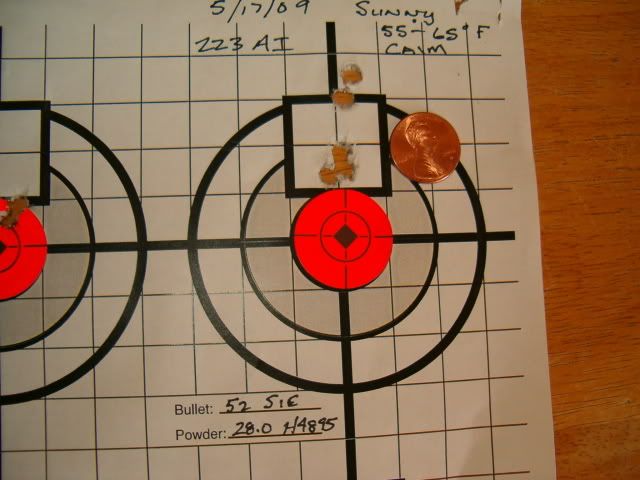
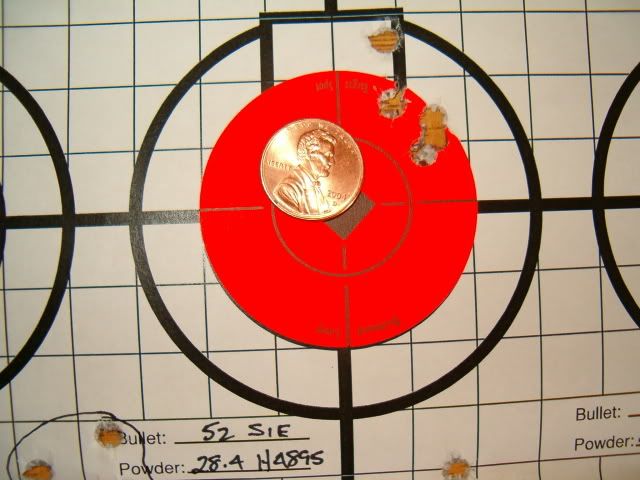
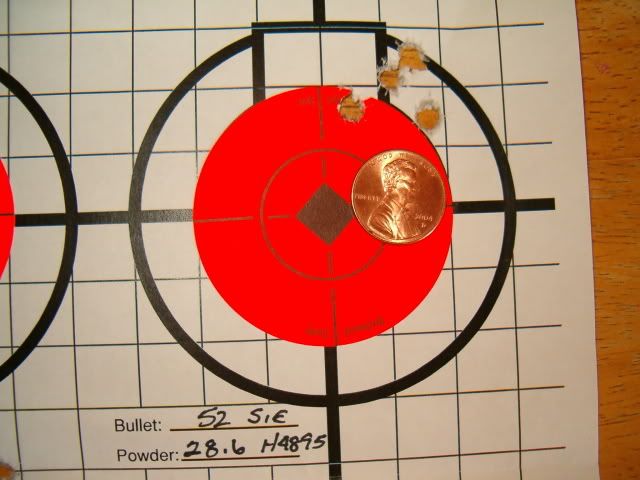

I am going to work with the loads of H4895 in the 28.4-28.6 gr range and play with seating depth a little. The horizontal stringing that I was getting is now gone and I will be putting better glass on the rifle at the end of the month. There is hope yet.
After checking the bedding, replacing the screws in my front base and cleaning up the crown I finally made it back to the range. Groups are more consistent than before but I am still seeing the same three in one hole and two in another phenomenon.




I am going to work with the loads of H4895 in the 28.4-28.6 gr range and play with seating depth a little. The horizontal stringing that I was getting is now gone and I will be putting better glass on the rifle at the end of the month. There is hope yet.
dan newberry
New member
It is normal to see split groups when you're using a non-optimal powder charge.
Go to my main OCW webpage at www.clik.to/optimalchargeweight and read especially the OCW versus the Ladder Test. Ladder tests are ineffective about 1/3 of the time, based on what we now know is going on with the acoustic shock wave (not the harmonic vibration of the barrel, which is another thing entirely).
When the shock wave is at the muzzle, you'll get what I call the "scatter node" and what you'll see is a widely spread out group, for no readily apparent reason (this is assuming that the rifle shoots consistently well with other proven load recipes).
Here is an OCW test target I shot a while back...

You shoot these tests in round robin fashion, for reasons explained at my site. You'll see that the two higher graduations both split (the shot marked "pulled" is not to indicate a called flyer, just to point out that the rifle is favoring two points of impact at that powder charge, as well as the one below it).
But look at the first two charges. Same POI for both graduations... so I chose as the OCW (optimal charge weight) a charge of 40.7 grains. At the 40.7 grain level, there is room for pressure varations without causing a debilitating change in point of impact (no flyers). /ubbthreads/images/graemlins/wink.gif So that's what you're looking for, a load that is pressure tolerant.
This isn't to necessarily just allow you to throw charges with less concern as to the exact tenth of a grain--but rather also to accommodate the odd primer, or odd brass case that might creep into the shell box. With an OCW load you'll see flyers far less often when these anomalies come to call.
So what I'd do is go back to the drawing board and shoot an OCW test, and then let's analyze the target. It looks like at 28.6 grains the 4895 load had come together. If 28.6 grains is the Optimal Charge Weight, it would follow that somewhere around the 28.0 grain mark would be the scatter node, i.e. the shock wave is at the muzzle, causing too much obturation of the bore during bullet release. Since this shock wave turns and goes back to the chamber (it does this at the speed of sound in steel, at around 18,000 fps, back and forth three or four times before the bullet exits the muzzle), all you must do to have the bullet exit when the shock wave is back at the chamber end (the best possible time, when the muzzle is at its calmest), is to add a bit more powder to accelerate the bullet a bit faster... then voila, the group tightens.
Again, this is not about harmonic muzzle whip. That's another matter which can be dealt with by adjusting seating depth of the bullet.
We've found that once you see where the scatter node charge is (seemingly 28.0 grains in the 4895 load you show), once you add about 1.5% to the powder charge, you're in the OCW zone and accuracy comes around.
I would be curious to see how 28.8 grains looks with that load recipe also.
Dan
Go to my main OCW webpage at www.clik.to/optimalchargeweight and read especially the OCW versus the Ladder Test. Ladder tests are ineffective about 1/3 of the time, based on what we now know is going on with the acoustic shock wave (not the harmonic vibration of the barrel, which is another thing entirely).
When the shock wave is at the muzzle, you'll get what I call the "scatter node" and what you'll see is a widely spread out group, for no readily apparent reason (this is assuming that the rifle shoots consistently well with other proven load recipes).
Here is an OCW test target I shot a while back...

You shoot these tests in round robin fashion, for reasons explained at my site. You'll see that the two higher graduations both split (the shot marked "pulled" is not to indicate a called flyer, just to point out that the rifle is favoring two points of impact at that powder charge, as well as the one below it).
But look at the first two charges. Same POI for both graduations... so I chose as the OCW (optimal charge weight) a charge of 40.7 grains. At the 40.7 grain level, there is room for pressure varations without causing a debilitating change in point of impact (no flyers). /ubbthreads/images/graemlins/wink.gif So that's what you're looking for, a load that is pressure tolerant.
This isn't to necessarily just allow you to throw charges with less concern as to the exact tenth of a grain--but rather also to accommodate the odd primer, or odd brass case that might creep into the shell box. With an OCW load you'll see flyers far less often when these anomalies come to call.
So what I'd do is go back to the drawing board and shoot an OCW test, and then let's analyze the target. It looks like at 28.6 grains the 4895 load had come together. If 28.6 grains is the Optimal Charge Weight, it would follow that somewhere around the 28.0 grain mark would be the scatter node, i.e. the shock wave is at the muzzle, causing too much obturation of the bore during bullet release. Since this shock wave turns and goes back to the chamber (it does this at the speed of sound in steel, at around 18,000 fps, back and forth three or four times before the bullet exits the muzzle), all you must do to have the bullet exit when the shock wave is back at the chamber end (the best possible time, when the muzzle is at its calmest), is to add a bit more powder to accelerate the bullet a bit faster... then voila, the group tightens.
Again, this is not about harmonic muzzle whip. That's another matter which can be dealt with by adjusting seating depth of the bullet.
We've found that once you see where the scatter node charge is (seemingly 28.0 grains in the 4895 load you show), once you add about 1.5% to the powder charge, you're in the OCW zone and accuracy comes around.
I would be curious to see how 28.8 grains looks with that load recipe also.
Dan
Evil_Lurker
New member
Dan,
I have a question for you:
If I have found a very accurate factory load (let's say it's Hornady's Varmint Express w/ 55 gr. V-Max. in .223 Rem., just as an example) /ubbthreads/images/graemlins/wink.gif, and would like to duplicate it (not knowing the actual powder they use),
would it be a good approach to chrony the load and then try and match that velocity (using a 55 gr. V-Match)?
It seems reasonable to me, more and more, to develop loads to a velocity the particular rifle shoots well, vs. doing a series of ladder tests with each powder.
But maybe that won't work. /ubbthreads/images/graemlins/confused1.gif
What do YOU think about it?
Thanks.
I have a question for you:
If I have found a very accurate factory load (let's say it's Hornady's Varmint Express w/ 55 gr. V-Max. in .223 Rem., just as an example) /ubbthreads/images/graemlins/wink.gif, and would like to duplicate it (not knowing the actual powder they use),
would it be a good approach to chrony the load and then try and match that velocity (using a 55 gr. V-Match)?
It seems reasonable to me, more and more, to develop loads to a velocity the particular rifle shoots well, vs. doing a series of ladder tests with each powder.
But maybe that won't work. /ubbthreads/images/graemlins/confused1.gif
What do YOU think about it?
Thanks.
dan newberry
New member
You can get a bullet out of the barrel at a given velocity, but if the acoustic shock wave isn't back at or near the chamber end when the bullet exits, the groups won't be pretty. (The acoustic shock wave is set into motion by the powder charge going off--imagine banging a piece of steel with a hammer and listening to it ring... this wave passes back and forth from chamber to muzzle 3 or 4 times before the bullet exits the barrel).
The above is why you often find that your best grouping load is not always the one with the best extreme spread in velocity.
So in other words, you can have the velocity, but the accuracy may not be there.
Different powders will accelerate the bullet faster than others... so you'll get one powder that burns a bit slower but pushes harder on down the bore making the same muzzle velocity as a quicker burning powder that peaks and wanes faster. Think about two drag racers... one leaves the line quicker and accelerates to max speed faster, but the other one crosses the finish line a split second later, but at the same speed.
But in the barrels, the shock wave begins at the same time, and reverberates back and forth at the same speed, regardless of what the bullet is doing, how fast it's accelerating, etc. So one bullet pushed by powder "A" can exit the muzzle at 3000 fps, and have spent a tiny bit more time in the bore than powder B's bullet, even though it exits at that same 3000 fps.
With all this said, if you're using the exact same powder and other components that the factory round is using, as well as the same neck tension (which will affect barrel time to a degree), then you could as you suggest load to that magic velocity and that ought to find you in the neighborhood you're wanting to be in.
FWIW, Hornady uses a lot of W748, by the way. They don't even claim it's a proprietary blend, either. I've had a couple of different Hornady ballistics techs admit that W748 is the propellant in particular cartridges I've dismantled and wondered about. /ubbthreads/images/graemlins/smile.gif
Of course velocities can plateau for a short while on the continuum, and you might find that a full grain of powder doesn't give any more velocity, but it does give more accuracy (for example, 43.5 grains gives you 2860 fps with a high extreme spread... and 44.0 grains brings the extreme spread in a bit, but you're still averaging somewhere around 2860 fps... and even at 44.5 grains, velocity doesn't seem to have risen that much, but accuracy has. Just a subtle difference in barrel time will make all the difference between a ho-hum load recipe and a great one.
Dan
The above is why you often find that your best grouping load is not always the one with the best extreme spread in velocity.
So in other words, you can have the velocity, but the accuracy may not be there.
Different powders will accelerate the bullet faster than others... so you'll get one powder that burns a bit slower but pushes harder on down the bore making the same muzzle velocity as a quicker burning powder that peaks and wanes faster. Think about two drag racers... one leaves the line quicker and accelerates to max speed faster, but the other one crosses the finish line a split second later, but at the same speed.
But in the barrels, the shock wave begins at the same time, and reverberates back and forth at the same speed, regardless of what the bullet is doing, how fast it's accelerating, etc. So one bullet pushed by powder "A" can exit the muzzle at 3000 fps, and have spent a tiny bit more time in the bore than powder B's bullet, even though it exits at that same 3000 fps.
With all this said, if you're using the exact same powder and other components that the factory round is using, as well as the same neck tension (which will affect barrel time to a degree), then you could as you suggest load to that magic velocity and that ought to find you in the neighborhood you're wanting to be in.
FWIW, Hornady uses a lot of W748, by the way. They don't even claim it's a proprietary blend, either. I've had a couple of different Hornady ballistics techs admit that W748 is the propellant in particular cartridges I've dismantled and wondered about. /ubbthreads/images/graemlins/smile.gif
Of course velocities can plateau for a short while on the continuum, and you might find that a full grain of powder doesn't give any more velocity, but it does give more accuracy (for example, 43.5 grains gives you 2860 fps with a high extreme spread... and 44.0 grains brings the extreme spread in a bit, but you're still averaging somewhere around 2860 fps... and even at 44.5 grains, velocity doesn't seem to have risen that much, but accuracy has. Just a subtle difference in barrel time will make all the difference between a ho-hum load recipe and a great one.
Dan
Dan, I've used OCW successfully on several rifles. I have been reading about OBT (Optimal barrel time) and it seems to draw on the shock wave idea too.
Have you seen or tried the OBT method to see if it correlates with the OCW method. I plan to soon but haven't been able to get out and shoot lately.
Have you seen or tried the OBT method to see if it correlates with the OCW method. I plan to soon but haven't been able to get out and shoot lately.
dan newberry
New member
Chris Long (techshooter on our PR forums) is the inventor of the OBT method.
I invented OCW, but it took Chris to explain why OCW works. Chris is a well studied, former Boeing aerospace engineer, a heck of a brilliant guy. He has also designed software for RSI ballistics labs.
Chris contacted me some years back, interested in OCW, and he had some insights as to why it worked as well as it did, and also why it is statistically superior to the conventional ladder test.
I'm a bit of a techno-phobe, I must admit, and therefore don't use OBT as often as I probably ought to to get to the best range to test for OCW loads in. I tend to use instincts more often these days... they're usually close enough to keep me from wasting too much powder and bullets. /ubbthreads/images/graemlins/smile.gif
But yes, I'm very familiar with OBT, as Chris and I have worked together often in the past on matters of reloading.
Dan
I invented OCW, but it took Chris to explain why OCW works. Chris is a well studied, former Boeing aerospace engineer, a heck of a brilliant guy. He has also designed software for RSI ballistics labs.
Chris contacted me some years back, interested in OCW, and he had some insights as to why it worked as well as it did, and also why it is statistically superior to the conventional ladder test.
I'm a bit of a techno-phobe, I must admit, and therefore don't use OBT as often as I probably ought to to get to the best range to test for OCW loads in. I tend to use instincts more often these days... they're usually close enough to keep me from wasting too much powder and bullets. /ubbthreads/images/graemlins/smile.gif
But yes, I'm very familiar with OBT, as Chris and I have worked together often in the past on matters of reloading.
Dan
Evil_Lurker
New member
Thanks Dan.
I'll tear one down, see if it appears to be 748, and proceed from there. If it doesn't work when I'm at the factory velocity, I'll ladder test it and work that angle.
748 is my powder of choice anyway, maybe I'll get lucky. /ubbthreads/images/graemlins/grinning-smiley-003.gif
I'll tear one down, see if it appears to be 748, and proceed from there. If it doesn't work when I'm at the factory velocity, I'll ladder test it and work that angle.
748 is my powder of choice anyway, maybe I'll get lucky. /ubbthreads/images/graemlins/grinning-smiley-003.gif
I have been chasing animals with my stick and string for the past few months so the project was put on the back burner. I finally bedded the action last week and took it out for a test run yesterday. Here are some results.
Before


After
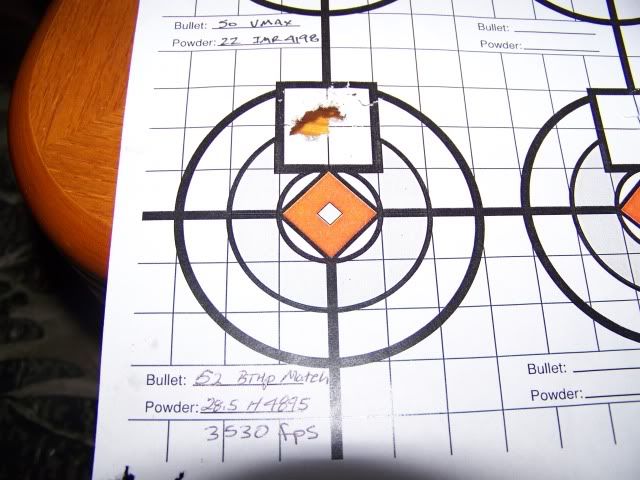
That velocity should read 3630fps, I just noticed my bad.
200yd
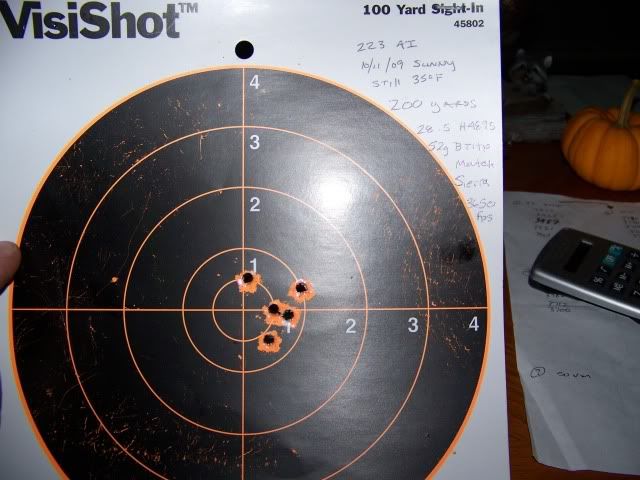
Can't complain coming from a sport weight barrel and a 9x scope. I would say the bedding job made a noticeable difference.
I did try another load with 40gr BT and TAC that showed promise.
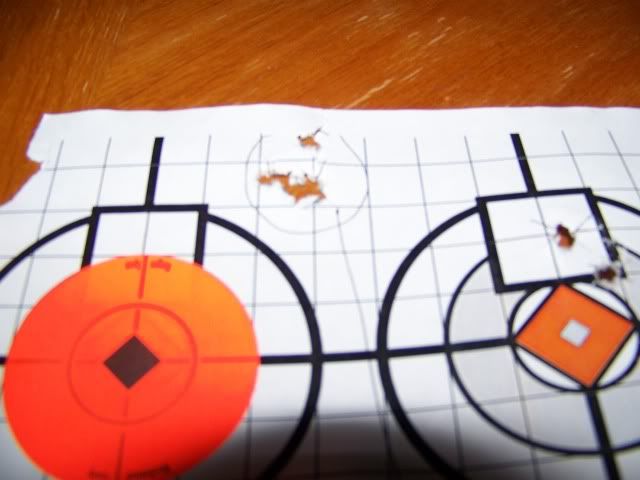
I made a bad 5th shot in this group. The velocities are a tame 3750 but the rifle did not like any hotter load.
I still need to put better glass on the rifle, but it will defiantly do for coyote season. Thanks everybody for the help and suggestions.
Before


After

That velocity should read 3630fps, I just noticed my bad.
200yd

Can't complain coming from a sport weight barrel and a 9x scope. I would say the bedding job made a noticeable difference.
I did try another load with 40gr BT and TAC that showed promise.

I made a bad 5th shot in this group. The velocities are a tame 3750 but the rifle did not like any hotter load.
I still need to put better glass on the rifle, but it will defiantly do for coyote season. Thanks everybody for the help and suggestions.
Linefinder
New member
Dan....great explanation, and I agree completely.
A buddy of mine and I have been using Chris Long's OBT table in conjunction with QuickLoad for about three years now. Once you've tweaked the burn rate of the powder (and taken into account some other variables), hitting within 5% of one of his barrel time nodes almost invariably results in the best accuracy the rifle/load combo is capable of.
All our Pdog rigs plus our competition BR rigs are shooting loads so derived. The really nice thing is, it doesn't take a whole lot of testing to discover a good load using this method.
I found my competition BR load within 25 rounds, and 5 of those were for confirmation. My friends results have been very similar.
Mike
A buddy of mine and I have been using Chris Long's OBT table in conjunction with QuickLoad for about three years now. Once you've tweaked the burn rate of the powder (and taken into account some other variables), hitting within 5% of one of his barrel time nodes almost invariably results in the best accuracy the rifle/load combo is capable of.
All our Pdog rigs plus our competition BR rigs are shooting loads so derived. The really nice thing is, it doesn't take a whole lot of testing to discover a good load using this method.
I found my competition BR load within 25 rounds, and 5 of those were for confirmation. My friends results have been very similar.
Mike

